NOTE: If you are looking for wetsuit thickness/water temperature chart for scuba diving check this article.
What wetsuit, what thickness of neoprene to choose for certain water temperature? It depends on a couple of factors and water temperature is just one of them. When choosing the right wetsuit for a certain water temperature and conditions, the main factors to consider are water temperature, air temperature, wind, cold sensitivity and activity. Lets take a look at what each of them means (if you just want the thickness/temperature chart skip this and go down):
Water temperature
This one is the main factor and the most obvious one – in colder water you need a thicker wetsuit. Obviously. An interesting fact here is that water pulls heat out of your body about 25 times faster than air! Or to be more precise – it’s conductivity is 25 x conductivity of air (conductivity of a substance is defined as ‘the ability or power to conduct or transmit heat). Basically this means that you wouldn’t last very long in cold water without a wetsuit and would die of hypothermia.
How Long Can a Person Survive in Cold Water (Without a Wetsuits)?
The coldest water you can find will usually be around 39-41-degree F/ 4-5 degree C (remember the water density before it turns to ice lesson from high school?). Generally, a person can survive in water at that temperatures for 10 to 20 minutes. This is how long it would take for the body temperature to drop down to between 70 and 80 degrees F/ 21 – 27 degrees C. This is when cardiac arrest usually occurs. Even before that moment muscles get weak, you lose coordination and strength… But ice cold water is not the only one that is dangerous. Because of the before mentioned conductivity even water temperatures as high as 75 – 80 degrees F / 24 – 27 degrees C can be dangerous. Here is the expected survival time in correlation with water temperature:
Water Temperature And Expected Time of Survival Chart
| Water Temperature | Expected Time Before Exhaustion or Unconsciousness | Expected Time of Survival | |
|---|---|---|---|
| (°F) | (°C) | ||
| 32.5° | 0.3° | < 15 minutes | 45 minutes |
| 32.5–40° | 0.3–4.4° | 15 – 30 minutes | 30 – 90 minutes |
| 40–50° | 3.3–10° | 30 – 60 minutes | 1 – 3 hours |
| 50–60° | 10–15.6° | 1 – 2 hours | 1 – 6 hours |
| 60–70° | 15.6–21.1° | 2 – 7 hours | 2 – 40 hours |
| 70–80° | 21.1–26.7° | 3 – 12 hours | 3 hours – indefinite |
| > 80° | > 26.7° | Indefinite | Indefinite |
Air temperature
Air temperature is a lot of times connected with water temperature. Warmer air & water in summer, colder in winter time. But there are places where ocean currents influence water temperature so much, that it can be way off from what you would expect. So there are times when air and water temperature are “out of sync”. This is usually a problem if you expect warm water in hot weather. If its vice versa and you are surprised by warm water in cold winter you can just do a fist pump :). Anyway – a really hot and sunny day can decrease the feeling of cold despite the cold water.
Wind
Wind cools the surface of your body and increases the feeling of cold. So if you use your wetsuit in wind you need a thicker one. Wind is a serious factor and has quite a big influence on the feeling of cold. Check out this chart to get the feeling what kind of wind chill certain wind strengths bring:
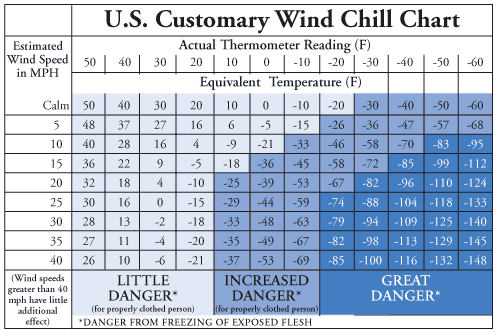
Cold sensitivity
Just how quickly do you get cold? Everyone has a bit different personal aversion to cold. Usually also men are more “immune” to cold than women.
Activity
What are you doing in the water and how active are you? For instance, you can surf so hard smoke comes from your ears or you can sit on your surfboard thinking, meditating and contemplating whatever. You can paddle your raft with all your power or you can calmly float underwater while diving. An active body produces more heat.
The Chart
The wetsuit thickness chart below is not carved in stone. It is for your orientation and is a bit on the safe side, so you can stay in the water longer. Or lets put it this way – it takes into the account that there is some wind present. A few more thoughts:
- Every person knows for himself how sustainable to cold he is and how quickly he gets cold.
- Thicker wetsuit also means you get tired sooner because your movements are more restricted.
- New and snug wetsuit will be warmer that an old, stretched out one of the same thickness.
- Quality of the wetsuit definitely counts (this is why good winter suits for low temperatures aren’t cheap).
Before we get to the temperature chart I can see some hardcore surfers complaining that they can surf in a shorty wetsuit in 59F (15 C) degree water. But why would you want to? I’ve had moments when blood slowly starts coming back to your fingers that are so numb you can’t get out of your wetsuit for half an hour and every heartbeat feels like someone is smashing your fingers with a hammer. When I thought my feet belong to some rubber dummy while I was cobblestone dancing out of the water. It is a part of why I love what I do and a great after dinner story. But I will take a little water behind my neck to cool down instead of this shit every time:).
You probably also found wetsuit/water temperature charts done by major wetsuit companies. Lots of them are in my opinion not very realistic. I guess they also partly use them for marketing purposes. Like: “You only need a 3/2 XY wettie in 54F (12C) water…because this the most technically advanced wetsuit on the planet is so advanced you can sleep in a freezer.” If they are not talking about the battery heated wetsuit, then they are probably full of shit.
WATER TEMPERATURE WETSUIT CHART
WATER TEMPERATURE |
WETSUIT THICKNESS |
WHAT TO WEAR |
|
| > 77 F > 25 C |
You don’t need a wetsuit, unless you usually wear a wetsuit to jacuzzi, sauna, to the beach… |  |
|
| 72F–77F 22C-25C |
Shorty when it gets colder outside, like in the morning, evening and if it is windy. If the weather is warm, you still don’t need a wetsuit. You can also get away with a good wetsuit top/vest. | ||
| 68F–72F 20C–22C | This is the comfortable bottom limit for surfing in shorty. Spring suit or 3/2 full suit is better for days without sun or if it gets windy. |  |
|
| 64F–68F 18C–20C |
Spring suit or full suit 3/2. If you only have one wetsuit and it is 4/3 – no worries, you can also use it. |  |
|
| 59F–64F 15C–18C |
A good 3/2 full suit is OK, but in the lower part of this range 4/3 wetsuit works better and in any weather. |  |
|
| 54F–59F 12C–15C |
Somewhere in the middle of this range booties become necessary, at least if you like to feel you feet. A 4/3 wetsuit will work. If you will do a lot of surfing in water at the bottom of this temperature range, you should get a 5/3. | 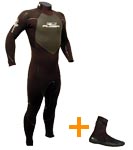 |
|
| 48F-54F 9C-12C |
5/3 or 5/4/3 wetsuit with booties. If it’s cold and windy also wear a hood and gloves. I hate wearing gloves so they are the last piece I put on. | 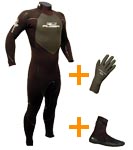 |
|
| < 48 F < 9 C |
5/3 can work, 6/5/4 is better, depends on how extreme do you want to get. Often it is not the thickness of the wetsuit, but bad booties, gloves etc that are the source of cold. So not only the wetsuit, also the booties, gloves and hood must be thick (at least 5mm). | 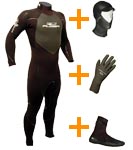 |
With good equipment, there is no limit for cold water surfing. With all the possible combinations people often ask which wetsuit thickness should they buy? In my experience: “If you only get one wetsuit – get a 4/3!” It is the most versatile and useful in widest range of temperatures.
Two Cold and Wet Wetsuit ‘Tricks’
Since we finished the chart with some really cold water, here are also two useful tips for putting on a cold wet wetsuit.
- Wet wetsuit is harder to put on than dry, not just because of the great and enjoyable wet and cold feeling but also because it sticks to your skin and it won’t go on. So to do it faster, put a PVC bag on you leg or arm before you push it through your wetsuit. Your arms/legs will slide through the sleeves like a hot knife through butter.
- The other trick is to have a dry rash guard in store. Put it on before you get into a wet wetsuit and you won’t feel the cold neoprene on your body.
The final trick would be to just suck it up and get over it as quickly as possible and then get into the water and catch a few while your buddies are still whining in the parking lot :).
PS: The is one more chart in this article as well.
PPS: If you find this article and char useful please share it on FB/Twitter etc… Many tnx!

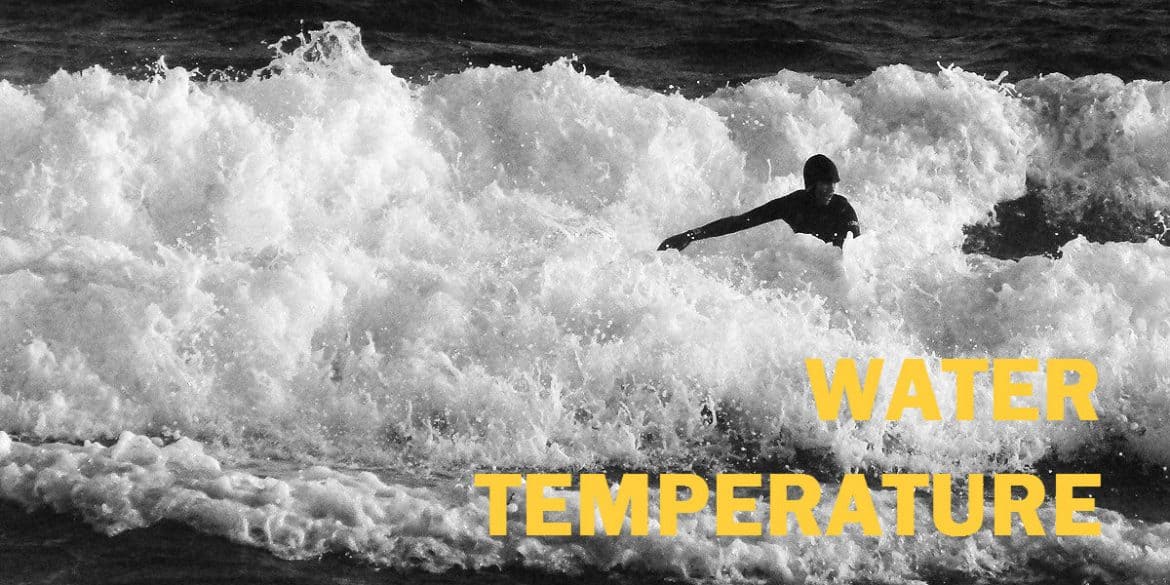
I recently started surfing, mostly east coast of canada. As you can imagine lots of cold water. Turns out I am allergic to neoprene, as all the good suits are made of neoprene I have no idea what to do. Tried fleece layering no good. I found the surfing drysuit possible solution, but I still need hood, boots and gloves as the best times are when really cold. If you have any help at all that would be great.
Thanks
hey man you should try the new rip curl flash bomb wet suit.. its made of a completely different kind of material. might save ya. far as booties and gloves no idea. unless ya look for something with a different backing on it. or go hardcore and dont wear any..
Jeff, try also the new geoprene neoprene. its made out of limestone, maybe it will work.
move south my blue friend but if not drysuit and wear a wool beanie under your squid lid
Is a 4/3 wetsuit too thick for spring / fall north florida surf? It gets as low 55, but would a 4/3 be to warm for when it gets around 67 degrees?
If it gets down to 55 you definitely need a 4/3. For 67 degrees water it will be a bit hot especially if you are active and catch a few waves in a row. If there are only a few days when you surf in water below ~59 then get a 3/2 otherwise a 4/3.
Yes I agree and some people run cool where others are warm blooded or more body fat. I was in Mazatlan maybe 77 f water but the offshore wind really cooled me I was so happy to borrow a long sleeve shorty. You see pros in Hawaii wearing long sleeve spring suits all the time. They are out there for long time with lots of wind. If you run cool I would even bring a 1/2 mil to Costa Rica just in case.
Dude this was totally helpful. I always wondered why a froze my ass off in Cali even in the summer. ;D I had some bullshit Play it Again Sports oldie suit that fit like dogbladder.
Cheers for this, the guide is fab and just what I need as I am soon to be training for my first open water 1 mile swim, needed some wetsuit info and now I have it! marvellous, thanks dudes
;D
yes the stormtrooper 6/5/4 bodyglove is awesome i trace carlos live in alaska and its my year round wet suit i kite surf and if you no what a slerpy is that what its like in the winter time in the ocean very cold but im farm in my wet suit good boots and warm gloves are key and hood ,,,
good guide i reckon, worth investing in a thermal rash vest too. with that i am warm down to 6 degrees with gloves boots and 2mm hood.(kitesurfing) Also means you can get your summer suit on sooner and have more freedom to move
If you need to wear a 3/2 fullsuit in 72 degree water, please go see a doctor immediately for a full physical.
I guess this guide is basically a good starting point for someone who has never stepped foot into water. You guys are playing it on the overly safe side a bit don’t you think?
I agree with what YeahRight stated. I’ve been in waters 68~ish° with boardshorts on. Round 66° was when the shorty came out. I guess take it with a grain of salt
i think you guys went a little overboard i pull out a shorty in about 65, 3/2 wet suit u can use when its 58 or higher
I grew up in Manhattan Beach, Ca and water temps in the summer are between 65-68 and EVERYONE swims and boards in bikinis and shorts. Every once in a while you’d see people in half suits… but they’re wussies!!! :)
I have been surfing for a few years now. i would say this is deffinitly a great guide for a beginner. just a few flaws:
if the water is above 70 you don’t need anything. maybe a 1 or 2mm jacket but not a spring.
spring=65-70
3/2=58-65
4/3=50-62(most versitile)
5/4=40-50
any colder then 40f then wtf are you doing out there?!?! but if you must get a 6/5
p.s. the bootie and glove suggestions are on the point, but the rest of the guide is playing it very safe. YOU WILL NOT BE COLD IN 70F WATER!!!!
it is safe :) also, as said, wind also a factor here.
Snorkeling regularly from spring time through fall, in depths usually no more than 20 feet, for the past five or so years off the cool coastal waters off Cape Cod shores, my friends and I typically use 3/2 full suits with rash suits, booties, gloves and hats of varying types to offset the numbing chill of the water quite well. We start the year as the water temp approaches 53 degrees F and go as long as Mid to late October to take in a full season of getting catching lobsters by hand. It’s a real hoot to outwit and capture these delectable creatures then have over for dinner the next couple of nights.
Do you know how many you are allowed to catch per day?
is it just me or is 68-72 beyond a trunking it situation?
Don’t know but it is looking strange to me
;D just went out in 40 f water and almost died…….p.s. i was bareback…cant feel my head
I’m a wakeboarder and I’ve ridden in 42 degree weather with a full body wetsuit and it’s not bad. I don’t wear a wetsuit when it’s 60+ It’s not that bad!
the temps posted are for sull submersion under the water– not surface boarding or snorkling! for the wussy coment you trying staying at 64 degree water 60 ft under for an hour and see if you don’t get cold
yeah..it seems like the temps are a bit on the safe side, but remember that is YOUR comfort in the water that matters. To all the chillers out there, my 5/4/3 keeps me warm in 34 degree water. :)
Looking back on 25 years surfing I think the guide is pretty good. It gives you a range for water temps in the context of topside conditions, which are critical to choosing the right suit on the day. Your personal cold resistance is going to depend on how much fat you carry, how active you are in the water and how well rested and fed you are on the day. If you want the most out of your time in the water, go for the slightly warmer option without unduely restricting your freedom of movement. I always take two with me and choose after I’ve scoped out the conditions. Keep ripping…
Honestly, the warmer you are the better you surf. If you follow this guide, you’ll never be cold and you’ll never be constricted by too much neoprene. If you wanna show off by showing people how cold of water you can stand then go for it, but it’s better to let your surfing do the talking.
That is the best comment I have seen on here! While I’m waiting for the next wave it’s nice not to feel cold.
Agree W/Ben and with the original comment, of course.
I was a bit cold surfing in morocco, I was in rashie and shorts, I dont need a full suit and hate surfing in them so I was going to get a long sleeved thermal rashie or a neoprene one, which is warmer does anyone know?
Neoprene is warmer than thermal rashie.
The chart is on the safe side, but it is a lot better to be safe than sorry. Nothing worse than your feet going numb after an hour and the waves are going off.
And I dont care how cold you can handle it. I am not trying to prove anything when I go out in 50 degree water. I am going out because the surf is good, and if the surf is good I want to be warm (not anywhere close to cold).
If the air temperature is 55 degrees and it’s windy and cloudy then 72 degree water will make you feel cold, and you’ll likely want a 3/2 suit (especially if you’re in the water awhile). This can be typical in the northeast U.S. particularly early morning in the summer.
Air temp in NY was in the low 80s yesterday, but with overcast skies, my teeth were chattering after an hour. Woulda gladly been called a wussy, but warm. :)
awesome awesome awesome!!! Where would farmer johns fit in??
Bobby, long john is about the same as springsuit
I work as a beach life guard in England east coast current water temp is 4 degrees c. During peak summer season it peeks at 9 to 12. We always wear a 3/2 shorty during this period, there is no need for a hood, gloves, boots and full thickness wetsuit you get exhausted after 5 mins of being in. I’ve always found rip curl wetsuits to be the best as well as I have used many different ones during my time working the beach and surfing.
A 3/2 shorty in 9C water??? :D :D :D
I had just bought a 2/3 full suit and was anxious to see just how well it worked so I filled the bathtub up and got the water down to about 45 degrees, I lasted about 6 min. Just incase anyone was retarded enough to try it. Thats the results your going to get lol.
I do have a realistic question and it might be a stupid one to some, but I just bought a very nice 12’6 paddle board and really wanting to take it out, problem is I live in Denver and the water temp is 50 degrees? Outside Temp is 50 degrees as well. So heres my question, would it be warmer to just put the 2/3 wet suit on with gloves and booties and get right on the board without getting anything wet, or soak for a couple minutes to get the suit wet then climb on the board? didnt know if getting the water in the suit would keep me warmer with my body then just letting the suit stay dry??? dont laugh to hard
thx
im assuming keep it dry
Joel, stay dry for sure!!! :) Neoprene insulation properties are not connected to the material being dry or wet, it’s just that wetsuits are never 100% waterproof (you have drysuits for that) and you always get some water inside the wetsuit. This water then gets heated by the body and you stay warm…but this is more of a consequence…not a conditions. Water pulls heat out of the body about 25 times faster than air so you are always warmer being dry than wet.
Here’s a trick you probably didn’t know about but works incredibly well.
I live in the south west of France and when the water gets really cold in jan/feb (11°C – 51°F) before putting on my 4/3 e-bomb I rub on some Bengay/Icy Hot on my arms, chest and legs. (+booties and gloves)
You can surf for over 2 hours and you won’t be cold. And it doesn’t leave a bad smell on your wetsuit. Just be careful not to touch your balls or your eyes when you put the cream on cos it’ll burn..
Great chart. Had to do some F/C conversion but not bad otherwise.
Question: if I have a 3/2 full, and its 11c air, 18c water with 15knot wind, will it be enough? I’ve got a 15 min walk to/from the beach and don’t want to get sick on the way back
3/2 will be enough
Me and the boys in Ireland be out for a few hours in 15 degrees in boardies. If your on a budget don’t bother with more than a good set of boardies unless the water temp is below 15°
Could you do a chart for spearfishing/freediving wetsuits? It is different from (above-)watersports wetsuits since you spend more time in the water, both at the surface and below and also different from scuba diving since you spend more time in the water and there is less of a pressure problem.
Thanks in advance
We might, thanks for the idea.
I wonder how much warmth is kept by a (woman’s) one piece neoprene swimsuit, 1 or 2 mm thick depending on brands, with either shorty legs or medium height leg cut ? Down to which temperature may it be comfortable for swimming or surfing ? Is there so much body heat loss around shoulders and hips and thighs that there is a price to pay on freedom of motion ?
Manu, a good 2mm swimsuit could IMHO be used in the same water conditions as a shorty wetsuits, somewhere down to 72F (22C). But I guess it depends on the design and cut of the swimsuit. If it’s more like a fashion type of suit with lots of holes then flushing could make it almost useless. But if it’s cut for minimal water leakage, reaching all the way up to the neck with smaller holes for arms and tight fitting, meant to keep swimmers warm, then it makes a difference.
Also – if you are using it for active swimming, you can shave off a few degrees.
What about wearing a 2mm vest with a 3/2 suit for 50F water (and 50F air – plus hood, booties, gloves)? And does it need to be worn under the suit as I’ve read one place? Can it be worn over?
Michelle, 50F is pretty cold, 5/3 wetsuit range. If you have hood, booties and gloves you will “survive” :) but but don’t expect to be in the water for a very long time. And put the vest under the 3/2, I think it works better this way.
I was out twice this week (11th November) in 50F water and 50F air temperature windsurfing for 2.5 hours each time, 25mph wind first day. I wore 7mm Rip Curl flash bomb boots which kept my feet toasty warm – much better than the 5mm Gul boots I have, I also had a 5/3 Gul winter wetsuit with gul thermal hooded vest, 3mm Gul gloves. I was fine + warm.
Thanks for this! I just got a wetsuit that’s pretty much doesn’t count as a wetsuit (long sleeve top, comes down to the upper thigh so works more like a jacket)
But I hate it when the weather is super hot, but then when I get into the water BOOM! too cold. So yeah, I want to at least keep my torso warm.
Todays wetsuits are SO MUCH better than before. I have been in 40degree water in a 4/3 with hood, 7 mm booties and 5mm gloves and was comfortable for two hours…..Whenever I am asked about what to buy I always tell the person not to skimp on quality for price. A good sealed 3/2 is better than those older 4/3 that we used to wear 10 years ago….they would leak through the seams and flush like mad….not fun. Your feet are always under the water so get the best boots you can afford. I only buy Xcel Drylock Booties. Cold feet or hands will ruin any surf session regardless of your core temp. Today, wetsuits do not have to be made of Neoprene. Limestone (Geoprene) and Rubber (Yulex) are two that are out there. They are more expensive but worth it (as well as being environmentally friendly) . They absorb much less water making them lighter to wear and warmer….something to look at.
Mark, thanks for the input! I agree, if there is one thing that you don’t want to be cheap on – it’s your wetsuit. I mean…if you surf cold water a lot. 40 degree is damn cold!:) Over here we usually get lots of wind together with the waves, so I prefer thicker neoprene, it’s not the water temp.that gets to you, its the windchill.
“Todays wetsuits are SO MUCH better than before.” Absolutely right. I’ve been surfing at Lake Ontario where water is near freezing point with 30+ mph winds – around 2 months ago, we had to walk through ice blocks to reach breaking point but 4/3 O’Neill Mutant (hooded) with 5mm gloves and boots always kept me warm for hours..it is crazy how much has evolved.
This is my second year of kayaking . I bought a short wet suit from R E I . I had it on this year and I am glad that I did . Because not only did I end up rolling the kayak once but twice . I don’t know the thickness of the wet suit . I just bought a new full body wet suit thats a 3/2 . I was looking at other wet suits to see if I got a good wet suiot and at a good price . But then I came upon a wet suit thats a 7m m and I was thinking of buying that suit . But I had found out that Thicker is not always better ..
It depends, it’s best if the thickness is just right for the water temperature. Thicker wetsuit just restricts your movements.
Canoeing in 50 degree (F) open ocean water, where an emergency could result in a long swim. We only end up in the water if we flip, an outrigger breaks or a hull comes apart. I’m looking at the Patagonia Long John (2 mil Yulex, with a vest-style top) and the NRS Long John (3 mil Neo, with a vest style top). Our upper body moves a lot more than you might think, thus the vest-style tops. I’d love to know how many minutes we could expect to survive in these suits. Also if anyone has any suggestions for upper-body protection that won’t bind our arms.
thanks!
I would go with 3mm, how long would a swim be? I think with a 3mm long john you could swim a really long time. 4mm would be ideal for that water temperature but it might be to warm for paddling, because swim is just the worst case scenario.
looks like i’m getting the 4/3. btw how warm can this get me? say a 58-62F water temp?
Any suggestion on a good brand? (with options for allergy friendly materials)
Yeah, a 4/3 is good for that temperature range. Wetsuits from all the main brands are pretty darn good these days, if you go with RipCurl, Xcel, Billabong, Oneil…you can not go wrong. For allergies it depends on what you are allergic to…check out Patagonia wetsuits, super warm and like 80% made out of yulex, plant based neoprene. Or maybe wetsuits made out of Geoprene, limestone based neoprene, I know Matuse wetsuits uses it.
Great guide thank you so much!
How much of a difference do the various thermal linings and such that are marketed make? Could one buy a thinner wetsuit based on technology, or does neoprene thickness trump all the rest, with features just being a bit of a bonus boost?
I wouldn’t buy a thinner wetsuit, thermal lining helps, but as you said neoprene thickness still wins. For me the biggest difference is that thermal lining feels much better/warmer on your skin than wet neoprene.
would a 4/3 wetsuit be too thin for 37 degrees i live in indiana and want to surf lake michigan in spring and they pretty much only sell 4/3 kids wetsuits. I can swim in 60 degree water without a wetsuit and be cold but not so cold that i can’t bear it.
Hey, yes, definitely to thin! For 37 degree water a 5/4 with integrated hood is bare minimum, I would get a 6/5 integrated hood and also thick 7mm booties and thick gloves. I guess there is usually also wind on the spot?